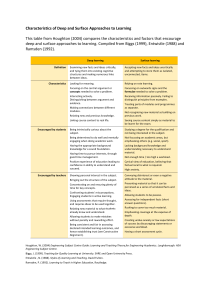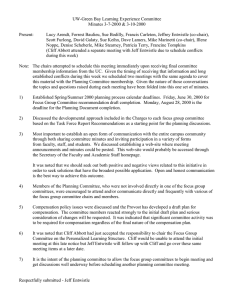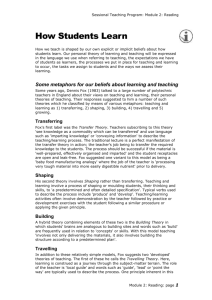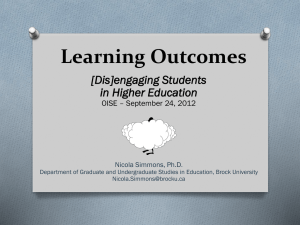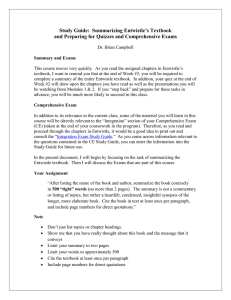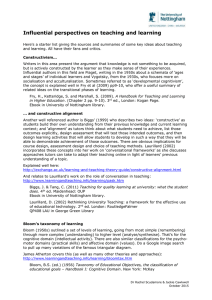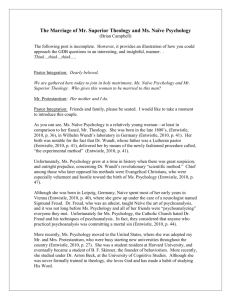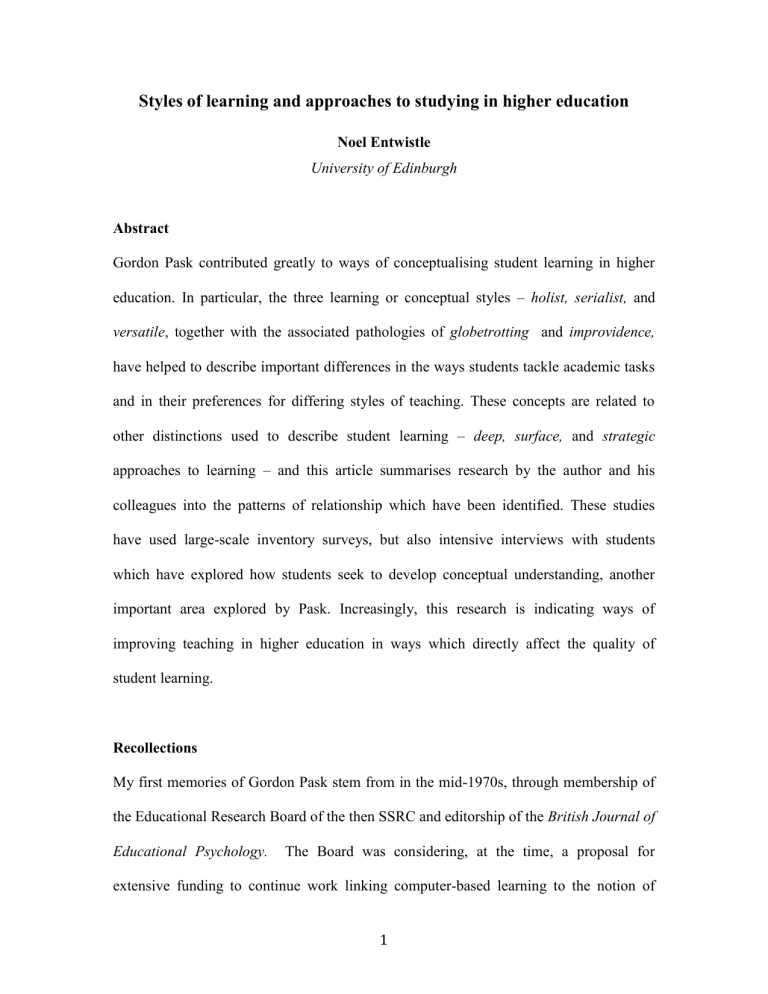
Styles of learning and approaches to studying in higher education Noel Entwistle University of Edinburgh Abstract Gordon Pask contributed greatly to ways of conceptualising student learning in higher education. In particular, the three learning or conceptual styles – holist, serialist, and versatile, together with the associated pathologies of globetrotting and improvidence, have helped to describe important differences in the ways students tackle academic tasks and in their preferences for differing styles of teaching. These concepts are related to other distinctions used to describe student learning – deep, surface, and strategic approaches to learning – and this article summarises research by the author and his colleagues into the patterns of relationship which have been identified. These studies have used large-scale inventory surveys, but also intensive interviews with students which have explored how students seek to develop conceptual understanding, another important area explored by Pask. Increasingly, this research is indicating ways of improving teaching in higher education in ways which directly affect the quality of student learning. Recollections My first memories of Gordon Pask stem from in the mid-1970s, through membership of the Educational Research Board of the then SSRC and editorship of the British Journal of Educational Psychology. The Board was considering, at the time, a proposal for extensive funding to continue work linking computer-based learning to the notion of 1 understanding in higher education (Pask and Scott, 1972, 1973). The ideas were seen by some referees as refreshingly original, and by others as implausibly idiosyncratic. On one thing all the referees agreed - the difficulty Gordon had in communicating his ideas to others who did not share his background. And few did, as Gordon’s thinking came from such a variety of experience, ranging from psychology and philosophy, to computing, engineering, and the theatre. His explanations drew on all these disparate areas, drawing freely on analogies to illustrate his ideas. But analogies depend on shared access, and the breadth of knowledge on which Gordon drew created problems for others, as I found. At this time, I was increasingly interested in ways of describing students’ learning strategies and had come across, first, Ference Marton in Gothenburg, who had introduced the concept of approaches to learning, and then Gordon Pask, with his notion of learning styles and strategies. I invited Gordon to Lancaster University to discuss with colleagues from Gothenburg possible connections between these two ways of describing student learning. The small seminar group gave the floor, first, to Gordon. He began to introduce the ideas behind his concept in considerable detail, writing enthusiastically in various parts of the blackboard. After about an hour, I tactfully suggested that it would be helpful to begin to point up the connections between his ideas and Marton’s. He paused, reflected, and said “Yes, of course. I’ll come to that in two and a half hours time.” And he did - leaving behind a blackboard with an amazing array of words and symbols, which was duly photographed as evidence of the extraordinary experience we had shared. The residual memory retains a confusing coexistance of feelings of excitement about the new connections established with frustration that they had been so 2 hard won. In his presentation, Gordon was trying to explain the contrast between contrasting learning strategies used by students in building up ther understanding of complex topics. He made great play of the entailment structures which described paths students followed in linking aspects of a topic and building up their understanding of it. Many of these entailment structures were complex in the extreme, bringing to mind the pattern of railway lines around Crewe station, when it was a major rail junction. In a break in the seminar, I suggested gently to Gordon that the entailment structures did not, to me at least, provide an easy illustration of the contrasting strategies of learning they were supposed to exemplify. He looked at me with a puzzled and pained expression, and then provided an alternative analogy. Unfortunately, as I pointed out to him, an appreciation of that analogy required a detailed knowledge of university level chemistry which I did not have. By this stage he was a little exasperated, but came up with yet another metaphor, which at last I could follow. He was trying to illustrate the difference between holist and serialist strategies of learning which stemmed from more consistent tendencies to adopt the learning styles or processes of comprehension and operation learning. Comprehension learning depends on a readiness to build overviews and relate ideas, while operation learning involves preferences for concentrating on cautious and critical examination of evidence in reaching conclusions. The analogy which I eventually found very helpful was based on the way a building is designed. The architect draws an outline of the building which shows how it would be seen within its surroundings, and also indicates the sizes and shapes of rooms, and how 3 they are positioned in relation to each other. This is the holist view; the outcome of comprehension learning. But no builder could begin work with just this information. The architect has also to provide substantial detail about the materials required and how, precisely, they are to be used. This detail in relation to the general outline depends on serialist strategies and operation learning. Later on the same day, I was due to take a revision seminar with first-year students. As we were to be discussing ideas about styles of learning, I thought the students might like to meet Gordon. What I told them initially was just that we had a visitor sitting in. During the subsequent discussion the students were asked to explain the differences between holist and serialist strategies. With due apologies to the students for misleading them, I then introduced Gordon and asked him to comment on what we had said about his concept. He explained his ideas with great clarity and simplicity, which suggested that the difficulties he had created for fellow researchers was more to do with his assumptions about what they knew, rather than with any fundamental difficulty in communicating his ideas. The use of inappropriate or overly complex metaphors was part of the difficulty Gordon had in convincing colleagues of the value of his ideas, but another problem stemmed from his redefinition of everyday words. He used terms like ‘understanding’, for example, with his own restricted technical meaning (Pask, 1976a), and the number of such redefinitions created a unique universe of potential meaning within which new readers became disorientated, confused, and even dismissive. Yet, the ideas, once fully grasped, were imaginative, original and powerful. They have contributed significantly to the growth of research on student learning by concentrating on the thinking processes 4 underlying the differing strategies students use in tackling their everyday academic tasks. Conceptualisations Styles and approaches Research on student learning was given a substantial fillip by the work of Marton and his colleagues in Gothenburg who introduced the term approach to learning (Marton & Säljö, 1976, 1997; Marton & Booth, 1997). The deep approach describes active engagement with the content, leading to extensive elaboration of the learning material while seeking personal understanding. In contrast, the surface approach indicates the use of routine memorisation to reproduce those aspects of the subject matter expected to be assessed. The research group in Gothenburg had carried out naturalistic experiments which showed how differing outcomes of learning could be attributed to contrasting intentions - either to develop personal understanding, or simply to cope instrumentally with the immediate task requirements. Subsequent quantitative and qualitative research within the everyday university context has developed the meaning of these two categories even further, as indicated in Table 1 (Biggs, 1987, 1993; Marton, Hounsell & Entwistle, 1997; Tait & Entwistle, 1996). These categories are not intended to replace ideas about ability, but rather to draw attention to the additional strong effects of the intentions and motives related to the tasks and overall learning contexts experienced in higher education. However, correlations with measured ability in university samples are generally low, although significant relationships have been reported with some aspects of personality (see Entwistle & Ramsden, 1983, p. 235) 5 Table 1 Defining features of approaches to learning Deep Approach Transforming Intention - to understand ideas for yourself by Relating ideas to previous knowledge and experience Looking for patterns and underlying principles Checking evidence and relating it to conclusions Examining logic and argument cautiously and critically Becoming actively interested in the course content ------------------------------------------------------------------------------------------------------------------------ Surface Approach Reproducing Intention - to cope with course requirements by Studying without reflecting on either purpose or strategy Treating the course as unrelated bits of knowledge Memorising facts and procedures routinely Finding difficulty in making sense of new ideas presented Feeling undue pressure and worry about work Biggs (1979) and Ramsden (1979) broadened these descriptions of students’ approaches to learning by questioning students about their everyday studying. Under those conditions, an achieving or strategic approach to studying was identified. This approach derived from an intention to obtain the highest possible grades, and relied on organised studying and an awareness of assessment demands. These studies also suggested that each of the three approaches was related to a distinctive form of motivation - intrinsic (deep), extrinsic and fear of failure (surface) and need for achievement (strategic). An earlier study had also identified contrasting ‘types’ of student, using cluster analyses of both motivation and personality (Entwistle & Wilson, 1977). Students motivated by need for achievement showed a stable personality 6 associated with self-confidence and ruthlessness. Intrinsic motivation was linked to syllabus-freedom and independent thinking, while fear of failure was related to anxiety and syllabus boundness. However, these descriptions suggest too static a picture of student learning, which is necessarily reactive to the learning context. Students’ approaches are affected by their prior educational and personal histories, which produce habitual patterns of studying. However, the content and context of the task also evoke strategies which are specific to that particular situation. Both consistency, up to a point, and a certain variability, have thus to be incorporated into descriptions of student learning (Entwistle, 1979). As already mentioned, these ideas were introduced at much the same time that Pask and Scott were reporting their experiments with students learning to work out for themselves the taxonometric principles of species of imaginary animals (Pask & Scott, 1972; Pask, 1976). He had asked students to learn the defining features of imaginary animals, and found that, in tackling this task, they used distinctively different strategies holist and serialist - which seemed to reflect more consistent, underlying learning styles or processes - comprehension learning and operation learning. The conditions used in Marton’s original experiment allowed students to decide for themselves whether or not they would seek to understand the meaning of the article for themselves. In Pask’s studies, students were required to reach a form of conceptual understanding, but they still went about it in quite different ways (Pask, 1988). In his work, therefore, the main distinction was in the student’s preference for learning in a particular way. A holist strategy and comprehension learning starts from a broad view of the task and constructs a personal, and often idiosyncratic, organising framework to 7 support understanding. In contrast, a serialist strategy and operation learning relies on step-by-step learning concentrating on details and examining the logic of the argument cautiously. Over-reliance on one or other of these strategies leads to a characteristic pathology in learning - either globetrotting (holist) or improvidence (serialist). The defining features of these two strategies and their pathologies are shown in Table 2. In Table 1, two pairs of learning processes were shown within the deep approach looking for patterns and relating ideas on the one hand, and cautious use of evidence and logic on the other. These can now be identified as equivalent to Pask’s comprehension learning and operation learning. Bringing these two learning processes together was seen by Pask as essential to thorough understanding within what he called a versatile style. He also found that some students relied on rote learning, a process which he distinguished from operation learning and represents an extreme surface approach. Table 2 Defining features of distinctive learning strategies (adapted from Pask, 1976) Serialist strategy Prefers step-by, tightly structured learning Focuses on the topic in isolation Concentrates on details and evidence Adopts a cautious logical stance, noting objections leading to Improvidence Fails to seek analogies or to use own experience Fails to make connections with related ideas -------------------------------------------------------------------------------------------Holist strategy Prefers personal organisation and a broad view Tries to build up own overview of topic Thrives on illustration, analogy, and anecdote Actively seeks connections between ideas leading to Globetrotting Fails to give sufficient attention to details Tends to generalise and reach conclusions too readily 8 Pask (1988) also showed that students learned more effectively if material was presented to them in their preferred style, rather than in its opposite. This demonstration of individual differences affecting learning has had substantial continuing repercussions in thinking about teaching in learning, not just in higher education but also in schools (see, for example, Entwistle, 1988a). Styles and understanding One of the reasons why Marton’s ideas have had such a strong and continuing influence on teaching and learning in higher education (at least in Britain and Australasia) is that the deep approach coincides with one of the main aims espoused by most academic staff (Entwistle, 1997; 1998a). The deep approach depends on the intention to understand, which then leads to the processes required to understand. If carried out thoroughly, and if the prerequisite knowledge and abilities are adequate, those processes culminate in a deep level of understanding. In the original experiment, Marton and Säljö (1976) had found an empirical association between approach and outcome. The nature of this relationship was investigated more fully in a study carried out subsequently by Entwistle, Hanley and Ratcliffe (1979) in Lancaster. Students were asked to read an article and answer questions which related both to what they had learned and how they had learnt it. Students’ responses were coded to indicate outcome (in terms of level of understanding, integration, and knowledge of main points) and approach to learning (based on the characteristics of deep and surface approaches). Principal components analyses were used to explore the inter-relationships between approach and outcome. Of the three main factors, the first brought together the three components of a deep level of understanding with the approach characteristics of ‘looking for meaning’ and ‘use of experience’. The second factor loaded highly on knowledge of the essential points, and picked up the other main component of the deep 9 approach included in this study - ‘relating facts to conclusion’. The final factor had high loadings on the surface characteristics of ‘looking for information’ and ‘memorisation’, combined with negative loadings on all but one of the indicators of deep approach and outcome. Whereas Marton (1976) had suggested that a deep approach would necessarily show all its defining features, these analyses indicated that some students concentrated more on facts and details in developing a deep understanding, whereas others were more concerned with personal meaning. This distinction paralleled Pask’s description of holist and serialist strategies, but also showed links with rather different kinds of outcome. Fransson (1977) had found differences in the learning outcomes of students which he attributed to both the amount of effort and the involvement shown during the learning process. Bringing these aspects together with the findings from Lancaster suggested the links between approach and outcome indicated in Table 3. Table 3 Approaches to learning and levels of understanding (adapted from Fransson, 1977, p. 250 and Entwistle, 1988b, p. 85) Approach to learning Level of understanding __________________________________________________________________________________________________________________________ Deep active Explains the author’s conclusion and examines how it was justified Deep passive Summarizes main argument accurately, without considering evidence Surface active Describes main points made without integrating them into an argument Surface passive Mentions a few isolated points or examples These differences in outcome can also be seen in relation to the SOLO taxonomy developed by Biggs and Collis (1982). This taxonomy describes how information is used in answering assessment questions. At the lowest levels - prestructural and unistructural - students drew on limited and often inaccurate information, equivalent to a surface 10 passive outcome. The next level was multistructural, in which answers contained several unrelated but pertinent points (surface active). The relational level showed an integration of the main points presented by the teacher (deep passive), while the extended abstract category showed a much deeper grasp of the material derived from previous knowledge and independent thinking (deep active). Differences in the outcomes of learning can, however, also be described in terms of the cycles of comprehension and operation learning required to reach a full understanding. In most of the Gothenburg studies, the outcomes of learning were produced within a naturalistic experiment, unaffected either by time constraints or by assessment pressures. In everyday studying, time constraints and competing pressures often prevent students from completing the processes which lead to full understanding, even when the intention is deep. Whether the reason for incomplete learning is a lack of effort, as Fransson suggests, or lack of time, the effect will be the same, and Pask’s work suggests that stylistic distinctions will also be found in the outcomes. The two factors covering a deep approach found in the Lancaster study, described above, provide tentative evidence that this type of difference does occur and suggest a more elaborate description of the links between approach, process, and outcome shown in Table 4 (Entwistle, Hanley & Hounsell, 1979; Entwistle, 1988b). Table 4 envisages a first stage of the deep, versatile approach to, say, a written assignment involving the building of an overall description of the topic which includes appropriate supporting detail, while the second stage depends is seen as involving connections being made with prior knowledge and between evidence and conclusions within the learning materials provided. When the student’s intention is also strategic, then combinations of deep and surface approaches may well be used, depending on the perceived requirements of the assessment procedures. The original version of this Table implied that operation learning was rooted in an intention to reproduce, whereas it is now clear that this style of thinking makes an 11 essential contribution to understanding, particularly in the sciences (Entwistle & Ramsden, 1983). However, when operation learning is carried out either casually, or without effective use of comprehension learning, it may well become indistinguishable from a surface approach. More generally, reliance on either comprehension or operation learning alone will lead to an incomplete form of understanding which exhibits the characteristic pathology of either globetrotting or improvidence. Table 4 Approaches , processes and outcomes of learning (adapted from Entwistle, Hanley and Hounsell, 1979. p. 376) Intention Approach/ Style Process Stage I Stage II Outcome __________________________________________________________________________________________________________________________ Deep Approach, Versatile Understanding All four processes below used in alternation to develop a full understanding Deep level of understanding --------------------------------------------------------------------------------------------------------------------------------------------- Comprehension Building overall Reorganizing, learning description of relating content area prior knowledge and Incomplete to ideas understanding due to globetrotting ___________________________________________________________________________________________________________________________ evidence Operation Incomplete learning Detailed attention to evidence and to conclusions, steps in argument Relating understanding critically due to improvidence Reproducing --------------------------------------------------------------------------------------------------------------------------------------------- Surface Approach Memorization Overlearning through routine memorization Surface level of understanding ___________________________________________________________________________________________________________________________ Achieving Strategic approach, well-organized studying Any combination of the six above processes considered necessary in carrying out the perceived task requirements successfully High grades with or without understanding Table 4 illustrates how the identification of the differing processes of learning 12 involved in developing understanding helps to explain some characteristic variations in the quality of learning outcomes observed by lecturers and tutors in higher education. Although the Table does not make it explicit, the processes of learning which Pask identified have to be seen as taking place in alternation. Their contrasting characteristics would make it impossible for them to coexist. This idea of alternation was discussed much earlier by Heath (1964) in describing the reasonable adventurer who ... appears to experience an alternation of involvement and detachment. The phase of involvement is an intensive and exciting period characterised by curiosity, a narrowing of attention towards some point of interest... This period of involvement is then followed by a period of detachment, an extensive phase, accompanied by a reduction of tension and a broadening range of perception,... reflect(ing) on the meaning of what was discovered during the involved stage. Meaning presumes the existence of a web of thought, a pattern of ideas to which the 'new' element can be related... - the critical attitude... We see, therefore, in (the Reasonable Adventurer) a combination of two mental attitudes: the curious and the critical. They do not occur simultaneously, but in alternation. (pp. 30-31) Pask’s categories, however, have provided a much more precise description of the contributions each way of thinking makes to the development of understanding (Entwistle, 1998b). In more practical terms, when lecturers or tutors look at students’ essays in terms of learning approaches, processes and pathologies it becomes easier to set up justifiable marking criteria. A good essay, for example, will exhibit the characteristics of a deep, versatile approach: it will have a clear structure (holist) with a critical evaluation of the evidence (serialist) in justifying a personal conclusion (holist), after a cautious consideration of alternatives (serialist). Conclusion This short paper has sought to explain the important contribution which Gordon Pask made to research on student learning. It came at a time when previous research had become bogged down in methodologies which sought only relationships between student characteristics and achievement, and drew almost exclusively from trait psychology. Both Pask and Marton made an important methodological shift by carrying out 13 naturalistic experiments - naturalistic in the sense that they investigated how students went about the learning of realistically complex content in contexts comparable to everyday studying. These experiments retained an element of experimental control, but also used interviews to explore how students had tackled the tasks they had been set. This combination of rigour and qualitative richness within the data-set led to important advances in thinking about teaching and learning in higher education. Gordon Pask’s particular contribution was in establishing the contrasting thinking processes underlying academic understanding, and this approach has stimulated a different, and altogether more fruitful line of research. For this breakthrough, I and many of my students and research colleagues over the years owe a debt of gratitude to Gordon Pask, and his imaginative grasp of the complexity which lies at the root of conceptual understanding. From a personal standpoint, it stimulated a continuing interest in the nature of academic understanding and its representation in memory, in notes and in essays (Entwistle, 1995; Entwistle & Entwistle, 1997; Entwistle, 1998b; Entwistle, McCune & Walker, 2001). References Biggs, J. B. (1979). Individual differences in study processes and the quality of learning outcomes. Higher Education, 8, 381-394. Biggs, J.B. (1987). Student approaches to learning and studying. Melbourne: Australian Council for Educational Research. Biggs, J.B. (1993). What do inventories of students' learning processes really measure? A theoretical review and clarification, Educational Psychology, 63, 3-19. Biggs, J. B., & Collis, K. E. (1982). Evaluating the quality of learning: The SOLO taxonomy. New York: Academic Press. Entwistle, N. J. (1979). Stages, levels, styles or strategies: Dilemmas in the description 14 of thinking. Educational Review, 31, 123-132. Entwistle, N. J. (1988). Styles of learning and teaching. London: David Fulton. Entwistle, N.J. (1988b). Motivational factors in students' approaches to learning. In R.R. Schmeck (Ed.), Learning strategies and learning styles (pp. 21-52). New York: Plenum. Entwistle, N.J. (1995). Frameworks for understanding as experienced in essay writing and in preparing for examinations. Educational Psychologist, 30, 47-54. Entwistle, N. J. (1997). Contrasting perspectives on learning. In F. Marton, D. J. Hounsell & N. J. Entwistle (Eds.), The experience of learning (2nd. Ed.) (pp. 3-22). Edinburgh: Scottish Academic Press. Entwistle, N. J. (1998a). Improving teaching through research on student learning. In J.J.F. Forest (Ed.) University teaching: International perspectives. New York: Garland. Entwistle, N. J. (1998b). Approaches to learning and forms of understanding. In B. Dart & G. Boulton-Lewis (Eds.), Teaching and learning in higher education: From theory to practice. Melbourne: Australian Council for Educational Research. Entwistle, N. J., & Entwistle, A. C. (1997). Revision and the experience of understanding. In F. Marton, D. J. Hounsell & N. J. Entwistle (Eds.), The experience of learning, (2nd. Ed.) (pp. 145-158). Edinburgh: Scottish Academic Press. Entwistle, N. J., Hanley, M., & Hounsell, D. J. (1979). Identifying distinctive approaches to studying. Higher Education, 8, 365-380. Entwistle, N. J., Hanley, M., & Ratcliffe, G. (1979). Approaches to learning and levels of understanding. British Educational Research Journal, 5, 99-114. 15 Entwistle, N. J., McCune, V. & Walker, P. (2001). Conceptions, styles and approaches within higher education: analytic abstractions and everyday experience. In R. J. Sternberg & L-F. Zhang (Eds.), Perspectives on cognitive, learning, and thinking styles. Mahwah, N. J.: Lawrence Erlbaum. Entwistle, N.J & Ramsden, P. (1983). Understanding student learning. London: Croom Helm. Entwistle, N.J., & Wilson, J.D. (1977). Degrees of excellence: The academic achievement game. London: Hodder & Stoughton. Fransson, A. (1977). On qualitative differences in learning. IV - Effects of motivation and test anxiety on process and outcome. British Journal of Educational Psychology, 47, 244-257. Heath, R. (1964). The reasonable adventurer. Pittsburg: University of Pittsburg Press. Marton, F. (1976). What does it take to learn? Some implications of an alternative view of learning. In N. J. Entwistle (Ed.), Strategies for Research and Development in Higher Education. Amsterdam: Swets & Zeitlinger. Marton, F., & Booth, S. (1997). Learning and awareness. Mahwah, N. J.: Lawrence Erlbaum. Marton, F., Hounsell, D. J., & Entwistle, N. J. (1997). The experience of learning (2nd. Ed.) Edinburgh: Scottish Academic Press. Marton, F., & Saljo, R. (1976). On qualitative differences in learning. I - Outcome and process. British Journal of Educational Psychology, 46, 4-11. Marton, F., & Saljo, R. (1997). Approaches to learning. In F. Marton, D.J. Hounsell & N.J. Entwistle (Eds.), The experience of learning (2nd. Ed.) (pp. 39-58). Edinburgh: 16 Scottish Academic Press (in press). Pask, G. (1976a). Conversational techniques in the study and practice of education. British Journal of Educational Psychology, 46, 12-25. Pask, G. (1976b). Styles and strategies of learning. British Journal of Educational Psychology, 46, 128-148. Pask, G. (1988). Learning strategies, teaching strategies and conceptual or learning style. In R. R. Schmeck (Ed.), Learning strategies and learning styles. New York: Plenum Press. Pask, G., & Scott, B. C. E. (1972). Learning strategies and individual competence. International Journal of Man-Machine Studies, 4, 205-229. Pask, G., & Scott, B. C. E. (1973). CASTE: A system for exhibiting learning strategies and regulating uncertainty. International Journal of Man-Machine Studies, 5, 17-52. Ramsden, P. (1979). Student learning and perceptions of the academic environment. Higher Education, 8, 411-427. Tait, H., & Entwistle, N.J. (1996). Identifying students at risk through ineffective study strategies. Higher Education, 31, 99-118. 17
